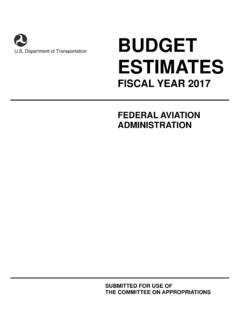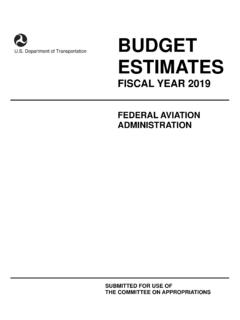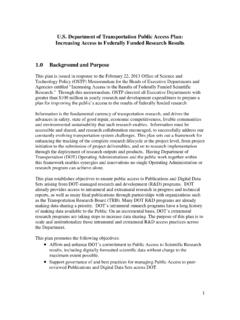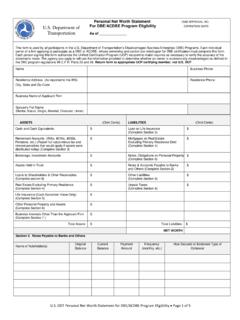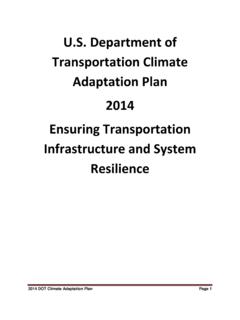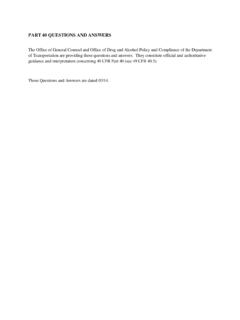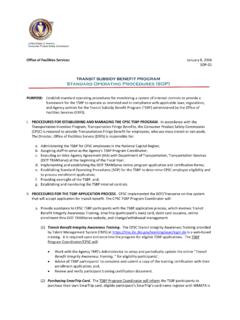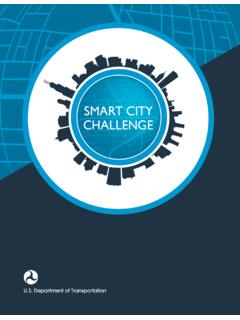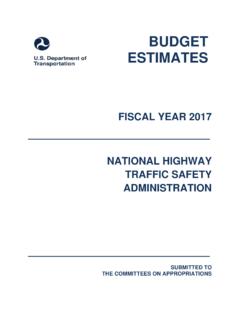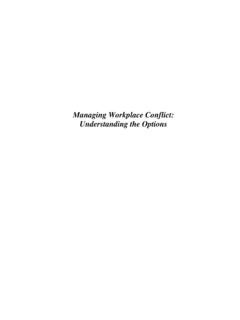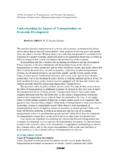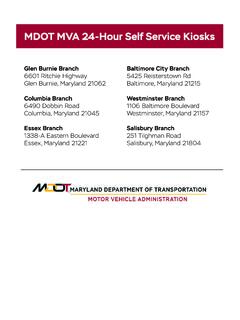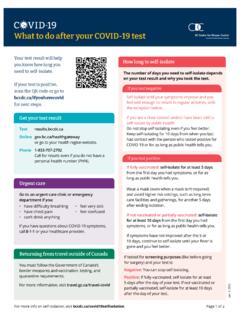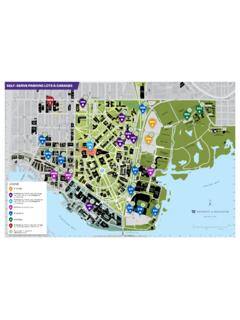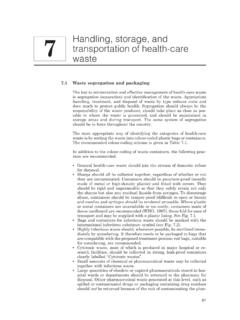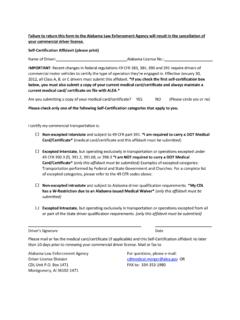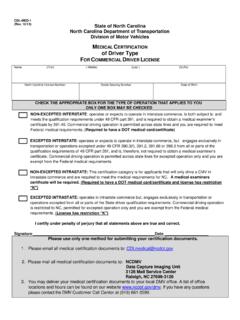Transcription of NHTSA Federal Automated Vehicles Policy - Transportation
1 Federal Automated Vehicles Policy Accelerating the Next Revolution In Roadway Safety September 2016. Federal Automated Vehicles Policy TABLE OF CONTENTS. Introductory 3. Executive 5. I. Vehicle Performance Guidance for Automated II. Model State 37. III. NHTSA 's Current Regulatory IV. Modern Regulatory Appendix I: NHTSA 's Current Regulatory 87. Appendix II: Regulatory Tools Used by Appendix III: Next 103. 1. Federal Automated Vehicles Policy 2. INTRODUCTORY MESSAGE. SECRETARY ANTHONY R. FOXX. DEPARTMENT OF Transportation . Technology in Transportation is not new. In fact, the airplane, the automobile, the train and the horse-drawn carriage all introduced new opportunities and new complications to the safe movement of people and goods. As the digital era increasingly reaches deeper into Transportation , our task at the Department of Transportation is not only to keep pace, but to ensure public safety while establishing a strong foundation such that the rules of the road can be known, under- stood, and responded to by industry and the public.
2 The self -driving car raises more possibilities and more questions than perhaps any other Transportation innovation under present discussion. That is as it should be. Possessing the potential to uproot personal mobility as we know it, to make it safer and even more ubiquitous than conven- tional automobiles and perhaps even more efficient, self -driving cars have become the archetype of our future Transportation . Still, important concerns emerge. Will they fully replace the human driver? What ethical judgments will they be called upon to make? What socioeconomic impacts flow from such a dramatic change? Will they disrupt the nature of privacy and security? Many of these larger questions will require longer and more thorough dialogue with government, industry, academia and, most importantly, the public. As the Department charged with protecting the traveling public, we recognize three realities that necessitate this guidance. First, the rise of new technology is inevitable.
3 Second, we will achieve more significant safety improvements by establishing an approach that translates our knowledge and aspirations into early guidance. Third, as this area evolves, the unknowns of today will become knowns tomorrow. We do not intend to write the final word on highly Automated Vehicles here. Rather, we intend to establish a foundation and a framework upon which future Agency action will occur. To do so, we have consulted with industry leaders, experts in the field, State government, the traveling public and safety advocates, among others. They have offered their input as we have asked them to share what they know. We thank them and recognize that, as this is a constantly changing area, all of us will continue to evolve. In addition to formally seeking public comment on this Policy , we also intend to conduct significant public outreach to seek input on our approach. We expect vigorous input and welcome it. Such feedback will inform our next update to this Policy , which we antic- ipate will be issued within one year and sooner if necessary and appropriate.
4 We very much look forward to the dialogues that will emerge in the coming weeks and months and thank you in advance for helping us. 3. Federal Automated Vehicles Policy 4. EXECUTIVE SUMMARY. For the last 50 years, the Department of Transportation (DOT) has been committed to saving lives and improving safety and efficiency in every way Americans move by planes, trains, automobiles, bicycles, foot, and more. DOT, through the National Highway Traffic Safety Administration ( NHTSA ), has carried out that mission on roadways in part by consistently embracing new technologies that make driving, riding, biking, and walking safer. Twentieth century automobile technologies (such as seat belts, air bags, child seats, and antilock brakes) developed in the private sector and brought to the nation's driving public through NHTSA 's safety programs and regulatory authority are responsible for saving hundreds of thousands of Today, the automobile industry is on the cusp of a technological transformation that holds promise to catalyze an unprecedented advance in safety on roads and highways.
5 The development of advanced Automated vehicle safety technologies, including fully self -driving cars, may prove to be the greatest personal Transportation revolution since the popularization of the personal automobile nearly a century ago. For DOT, the excitement around highly Automated Vehicles (HAVs) starts with safety. Two numbers exemplify the need. First, 35,092 people died on roadways in 2015 alone. Second, 94 percent of crashes can be tied to a human choice or An important promise of HAVs is to address and mitigate that overwhelming majority of crashes. Whether through technology that corrects for human mistakes, or through technolo- gy that takes over the full driving responsibility, Automated driving innovations could dramatically decrease the number of crashes tied to human choices and behavior. HAVs also hold a learning advantage over humans. While a human driver may repeat the same mistakes as millions before them, an HAV can benefit from the data and experience drawn from thousands of other Vehicles on the road.
6 DOT is also encouraged about the potential for HAV systems to use other complementary sensor technologies such as vehicle-to-vehicle (V2V) and vehicle-to-infrastructure (V2I) capabilities to improve system performance. These sensor technologies have their own potential to reduce the number and severity of crashes, and the inclusion of V2V and V2I capabilities could augment the safety and performance of HAV systems. The benefits don't stop with safety. Innovations have the potential to transform personal mobility and open doors to people and communities people with disabilities, aging populations, communities where car ownership is prohibitively expensive, or those who prefer not to drive or own a car that today have limited or impractical options. Cities will reconsider how space is utilized and how public transit is provided. Infrastructure capacity could be increased without pouring a single new truck load of concrete. HAVs may also have the potential to save energy and reduce air pollution from Transportation through efficiency and by supporting vehicle electrification.
7 5. Federal Automated Vehicles Policy Recognizing this great potential, this Policy sets out an ambitious approach to accelerate the HAV revolution. The remarkable speed with which increasingly complex HAVs are evolving challenges DOT to take new approaches that ensure these technol- ogies are safely introduced ( , do not introduce significant new safety risks), provide safety benefits today, and achieve their full safety potential in the future. To meet this challenge, we must rapidly build our expertise and knowledge to keep pace with developments, expand our regulatory capability, and increase our speed of execution. This Policy is an important early step in that effort. We are issuing this Policy as agency guidance rather than in a rulemaking in order to speed the delivery of an initial regula- tory framework and best practices to guide manufacturers and other entities in the safe design, development, testing, and deployment of HAVs. In the following pages, we divide the task of facilitating the safe introduction and deployment of HAVs into four sections: Vehicle Performance Guidance for Automated Vehicles Model State Policy NHTSA 's Current Regulatory Tools New Tools and Authorities 1.
8 Vehicle Performance Guidance for Automated Vehicles The Vehicle Performance Guidance for Automated Vehicles (or Guidance ) section outlines best practices for the safe pre-deployment design, development and testing of HAVs prior to commercial sale or operation on public roads. This Guidance defines deployment as the operation of an HAV by members of the public who are not the employees or agents of the designer, developer, or manufacturer of that HAV. This Guidance is intended to be an initial step to further guide the safe testing and deploy- ment of HAVs. It sets DOT's expectations of industry by providing reasonable practices and procedures that manufacturers, suppliers, and other entities should follow in the immediate short term to test and deploy HAVs. The data generated from these activities should be shared in a way that allows government, industry, and the public to increase their learning and understanding as technology evolves but protects legitimate privacy and competitive interests.
9 6. 2. Model State Policy Today, a motorist can drive across state lines without a worry more complicated than, did the speed limit change? The integration of HAVs should not change that ability. Similarly, a manufacturer should be able to focus on developing a single HAV fleet rather than 50 different versions to meet individual state requirements. State governments play an important role in facilitating HAVs, ensuring they are safely deployed, and promoting their life-saving benefits. The Model State Policy confirms that States retain their traditional responsibilities for vehicle licensing and registration, traffic laws and enforcement, and motor vehicle insurance and liability regimes. Since 2014, DOT has partnered with the American Association of Motor Vehicle Administrators (AAMVA) to explore HAV policies. This collaboration was one of the bases for the Model State Policy framework presented here and identifies where new issues fit within the existing Federal /state structure.
10 The shared objective is to ensure the establishment of a consistent national framework rather than a patchwork of incompatible laws. 3. NHTSA 's Current Regulatory Tools NHTSA will continue to exercise its available regulatory authority over HAVs using its existing regulatory tools: interpretations, exemptions, notice-and-comment rulemak- ing, and defects and enforcement authority. NHTSA has the authority to identify safety defects, allowing the Agency to recall Vehicles or equipment that pose an unreasonable risk to safety even when there is no applicable Federal Motor Vehicle Safety Standard (FMVSS). To aid regulated entities and the public in understanding the use of these tools (including the introduction of new HAVs), NHTSA has prepared a new information and guidance document. This document provides instructions, practical guidance, and assistance to entities seeking to employ those tools. Furthermore, NHTSA has stream- lined its review process and is committing to issuing simple HAV-related interpretations in 60 days, and ruling on simple HAV-related exemption requests in six NHTSA .
